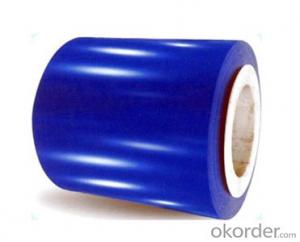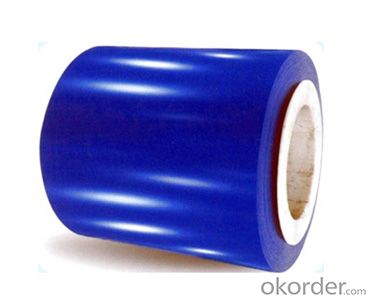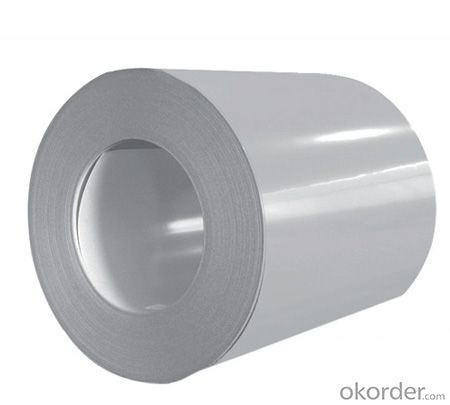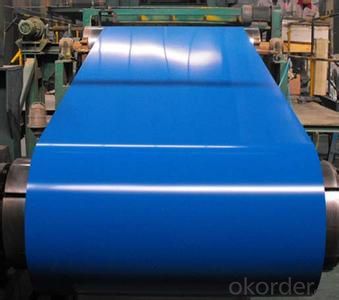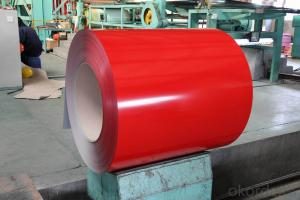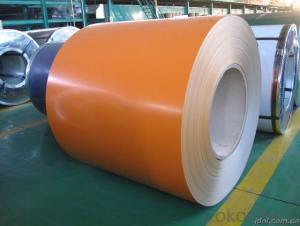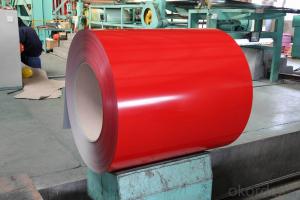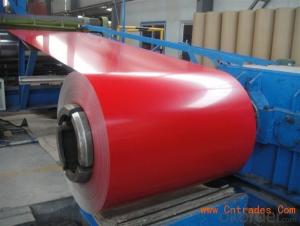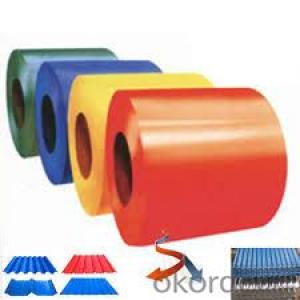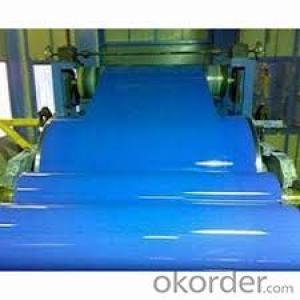Prepainted Steel Coil-CGC440
- Loading Port:
- China Main Port
- Payment Terms:
- TT OR LC
- Min Order Qty:
- -
- Supply Capability:
- -
OKorder Service Pledge
OKorder Financial Service
You Might Also Like
Prepainted Steel Coil-CGC440
Prepainted Galvanized Steel usually refersto have substrate processed with surface processed and coated then(rollercoated )or bonded organic thin film and baked, and it is able to beprocessed to final prodevtion .
Prepainted Galvanized Steel qualified with excellent decorative ,formability ,corrosionresistance ,coating adhesion ,can keep for a long time as well as maintainfresh color .For color coated steel sheet can obtain good economicbenefit by steel belt wood ,efficient in construction and save energy ,preventpollution etc.Which is an ideal material;for manufacturing board.
Specification:
Thickness:0.2-1.0mm
Width:600-1250mm
Length:on request
Zinccoating: 30-275g/m2
Color:RAL series
Paint:PE, PVDF, PU
Application:
1.Buildings and constructions:roofing, ceilings, gutters, venting lines, indoor decorations,windowframes, etc
2.Electrical appliances:computer shells, washing machines, refrigerators, dehumidifiers,videorecorders, water heaters, etc.
3. Agriculturalequipments: troughs, feeding tools, agricultural driers, irrigation channels,etc.
4. Vehicle parts: back-seat plates of buses and trucks, conveying systems, oil tanks, etc.
Advantages:
1. High strength
2. Well rainproof performance
3. Good corrosion
4. Easy to install and remove
- Q: Steel used to be made in the #92;Bessemer Converter, write about how steel making processes today produce better quality steel????
- Steel making today is a faster process as use Blast furnace which Coke Limestone Iron ore are fed into the top of the furnace. after these are fed in a exothermic happens and converts these ores into Iron. Iron is not strong enough to be used in thing this is formally known as pig iron. To convert Iron ore into steel it has to go to a process called the BOS Basic Oxygen Steel-making were oxygen is blown onto the iron ore for about 30 to 45 min and this then turns it into steel as all the impurities are taken out and this floats on top and known as slag and used for things such as road building. Once you have steel this is then pored into ladles and taken to the continuous caster and rolled into slabs, billets and bars and then cut off and rolled into a finished products and then taken to compniaes to be made into thins you see made out off metal such as skyscrapers. Hope this helps :o)
- Q: I am doing a project on how revolvers work and what materials they use and would like to know what specific grade of stainless steel they use for the manufacturing of the frame and cylinder?
- *Rifle barrels are usually made from steel alloys called ordinance steel, nickel steel, chrome-molybdenum steel, or stainless steel, depending upon the requirements of the cartridge for which they are chambered. The higher the pressure and velocity of a cartridge (pressure and velocity usually go up together), the faster it will wear out a barrel. To give a satisfactory service life, barrels for high velocity cartridges must me made from tougher and harder steel than barrels for lower pressure cartridges. *The 400 (416) series SS commonly known as ordnance grade , is what barrels are made from . *If you want your barrel to be made from super alloy then it is 718 Inconel ,but a costly affair.
- Q: What are the different types of surface treatments for steel coils?
- There are several types of surface treatments for steel coils, including galvanizing, painting, and coating. Galvanizing involves applying a layer of zinc to protect the steel from corrosion. Painting involves applying a layer of paint to provide both corrosion resistance and aesthetic appeal. Coating involves applying a thin layer of protective material, such as polymer or epoxy, to enhance the steel's durability and resistance to corrosion. These surface treatments are chosen based on the specific requirements of the steel coils and the desired end-use applications.
- Q: Can steel coils be coated with color-changing materials?
- Yes, steel coils can be coated with color-changing materials. These materials are typically applied as a topcoat or overcoat on the steel surface, allowing the coils to exhibit different colors or hues based on external factors such as temperature, light, or chemical reactions. This coating technology can provide visual appeal, aesthetic versatility, and even functional benefits to steel coils in various applications.
- Q: What are the common surface treatments for steel coils?
- The common surface treatments for steel coils include galvanizing, painting, and coating with protective films.
- Q: Can steel coils be bent or shaped?
- Yes, steel coils can be bent or shaped due to their flexibility and malleability.
- Q: What are the common coil widths available for steel coils?
- The specific application and industry requirements determine the different available coil widths for steel coils. However, the steel industry commonly offers several standard coil widths. These standard widths include: 1. Approximately 24 inches (610 mm): This coil width is frequently used in various applications, including automotive manufacturing, construction, and general engineering. 2. Approximately 36 inches (914 mm): The construction industry often employs this wider coil width for roofing and siding materials. 3. Approximately 48 inches (1219 mm): Manufacturing processes that require larger steel sheets, such as the production of appliances, HVAC systems, or industrial machinery, commonly employ this wider coil width. 4. Approximately 60 inches (1524 mm): Specialized applications in industries like automotive manufacturing, aerospace, or shipbuilding typically use this wider coil width. It is important to acknowledge that these are just some of the more common coil widths. Steel mills or suppliers may offer custom widths to meet specific customer requirements. Moreover, the availability of coil widths can vary depending on the supplier or steel mill.
- Q: How are steel coils inspected for surface finish using profilometry?
- Steel coils are inspected for surface finish using profilometry by measuring the surface topography using a profilometer. The profilometer scans the surface of the steel coil and records the deviations from the ideal surface. This data is then used to determine the roughness, waviness, and other surface parameters of the steel coil, providing a quantitative assessment of its surface finish quality.
- Q: What are the common sizes of steel coils?
- The common sizes of steel coils vary depending on the specific needs and requirements of different industries. However, there are some standard sizes that are commonly used in the steel manufacturing and processing sectors. These include: 1. Slit Coils: Slit coils are typically smaller in size and are commonly available in widths ranging from 0.5 inches to 72 inches. The weight of slit coils varies, but it is usually between 1000 pounds to 50,000 pounds. 2. Master Coils: Master coils are larger in size and are typically used in steel processing facilities to produce various steel products. The width of master coils usually ranges from 36 inches to 96 inches, while the weight may vary from 5,000 pounds to 60,000 pounds. 3. Sheet Coils: Sheet coils are often used in construction, automotive, and appliance manufacturing industries. The standard sizes for sheet coils vary, but they are commonly available in widths of 48 inches, 60 inches, and 72 inches, with lengths ranging from 96 inches to 240 inches. 4. Plate Coils: Plate coils are primarily used in heavy-duty applications such as shipbuilding, bridge construction, and pressure vessel manufacturing. The sizes of plate coils are typically larger, with widths ranging from 36 inches to 96 inches, and lengths varying from 96 inches to 480 inches. It is important to note that these sizes are not fixed and can be customized based on specific customer requirements. Steel manufacturers and suppliers often have the capability to produce coils in various sizes to meet the diverse needs of their clients.
- Q: I've been looking into battle-ready katanas a lot lately. And I've come across some debates between the best forges and steels to be used for them. The functional katanas I use now are Musashi brand katanas, using 1045 carbon steel. They each cost roughly $200-$250. The straight carbon steels are mentioned in the debates, but they aren't very sophisticated in their design. Now the higher end of this middle class of katana ($250-$1000) uses higher carbon. spring, damascus, and other various steels and combinations. I've heard a lot about the strength of damascus steel and it's cutting power. But I look for more than that. I've also been looking at (and for) durability, flexibility, and how well it stands up to contact. So I guess what I'm asking is for the opinion of people who have used these steels, and an answer on what the community thinks is the best steel for a mid range ($250-$1000) battle-ready katana. Looking forward to some good answers.
- This Site Might Help You. RE: Best battle-ready katana steel? I've been looking into battle-ready katanas a lot lately. And I've come across some debates between the best forges and steels to be used for them. The functional katanas I use now are Musashi brand katanas, using 1045 carbon steel. They each cost roughly $200-$250. The straight carbon...
Send your message to us
Prepainted Steel Coil-CGC440
- Loading Port:
- China Main Port
- Payment Terms:
- TT OR LC
- Min Order Qty:
- -
- Supply Capability:
- -
OKorder Service Pledge
OKorder Financial Service
Similar products
Hot products
Hot Searches
Related keywords
